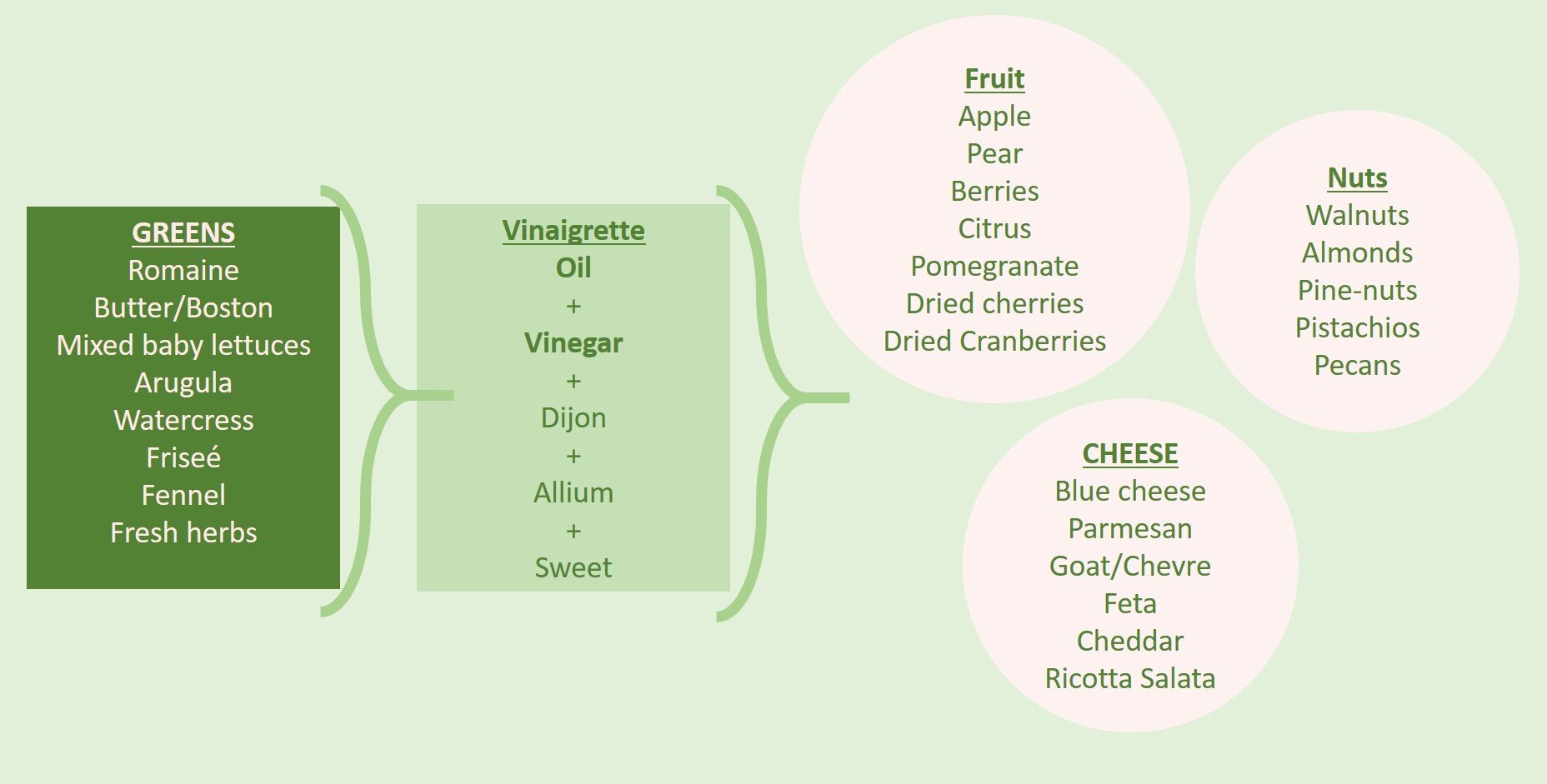Salad & Vinaigrette…building it better
This seasonal salad takes advantage of local fruits and veggies with a whipped feta cheese base.
Salad is a wonderful canvas for so many ingredients. There are potato, pasta, grain and bread salads, but for me, the “Green” salad reigns supreme. The beauty of a green salad with mixed lettuces and what I call the Salad Trinity ; fruit, nuts and cheese, is my favorite go to combination for my crispy greens. Below is my chart of my salad basics and potential add-ins, but the options really are endless.
For me, the Trinity of add-ons for crunchy and savory perfection comes from fruit, cheese and nuts.
Consider your greens, then mix it up. The most basic base of the salad is the lettuce, but I find a combination of greens is wonderful when you have the time to build the base. Many nights my standard base is all arugula. It has enough flavor to stand on its own with or without any fruits, nuts or cheese. But consider a buttery Boston lettuce, with some friseé and thinly sliced fennel. I consider vegetables and herbs “extended greens”; cucumber, cilantro, leeks, fennel, etc.. To that simple base, add some crisp/tart apple slices, toasted walnuts and paper thin slices of good Parmesan and top with parsley. Now that’s a party salad which would make a great start to any meal, or a perfect light summer lunch. Then consider a “winter” salad. Start with a baby lettuce mix, add watercress and mustard greens, then toasted pecans, a sharp cedar cheese and a vinaigrette with a little honey added to it. The seasons will guide you to the best choices, but be creative and mix it up. There is also something to be said for pure simplicity. I had a salad at Campanile in Los Angeles, Mark Peel’s amazing, but sadly now closed LA institution, that was an entire Butter/Boston lettuce, taken apart leaf by leaf, lightly dressed, then placed back on the salad plate looking like a giant rose. It was spectacular and delicious. The freshness of the lettuce was the star. It looked similar to this stunning butter lettuce salad below from CUT at the Dorchester Hotel, but without cheese or tomatoes, au natural, if you will.
Butter lettuce base, Blue cheese, tomatoes and fresh herbs (image from Cut at the Dorchester Hotel).
Sharpen it. After experimenting with your favorite lettuces, nuts and other salad elements, it’s time to make the vinaigrette. The only elements which are essential to the vinaigrette are oil and vinegar, salt and pepper. The accepted ratio amongst many chefs is 3:1, 3 parts oil to 1 part vinegar. Some people, like me, prefer a 2:1 oil to vinegar ratio which lends a sharper more acidic flavor profile. In my everyday salad at home, I simply pour the oil slowly over the salad, then sprinkle the vinegar over that. I sprinkle salt and pepper which clings to the oil and toss. For a little more special salad, I will make the vinaigrette in a measuring cup, measuring the oil and vinegar and then add Dijon mustard. And if I’m really trying, I’ll add minced shallots creating more of a show-off vinaigrette.
Oil. I use a good extra virgin olive oil on my salads. This is my base and I rarely change this. I always have a super premium oil from California or Spain, and prefer them to be single origin versus a varietal. I use the premium oil on salads and for final flourishes on hummus, pasta and anything else that benefits from a drizzle of liquid gold. Additionally, I have a decent olive oil, and neutral oils like avocado, sunflower or vegetable. I am a sucker for Truffle oil to use in pastas and of course a sesame oil, which I keep in the refrigerator because I don’t go through it as quickly as the others.
Vinegar. I have quite a variety of vinegar in my cabinet too. Red wine, which is my go to, white wine, champagne, sherry, rice, apple and if I can find it, tarragon vinegar. Vinegar is a very subjective acid, so it might take some trial and error before you land on one that you love. I used Regina red wine vinegar for decades in California, but when I moved to Virginia, I could not find it anywhere. I spent two years looking for a red wine vinegar I liked and that I could easily find. The point of all this is that vinegar is personal, and having a variety of them in your pantry will allow you to change the flavor profile of your vinaigrette to compliment your seasonal salad compositions.
Use the last bit of Dijon in the jar to make a creamy vinaigrette.
Make it right in the jar shaking all the remnants of the creamy Dijon into the dressing.
Take it up a notch. Now that you have the basics down, start to elevate the basic salad. In the salad at the top of the page, I started with my beloved cheese as a creamy feta base, resting the greens, fruit and tomatoes on top, then adding the dressing. Olive oil and vinegar is the vinaigrette classic, but consider other combinations: Tahini and lemon juice, yogurt and lime juice, peanut butter, orange juice and sesame oil with ginger. These different combinations can take your salad game around the world. Change up your greens and toppings to compliment the dressing, and you’ve become a salad master.





